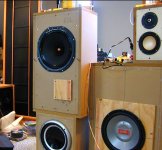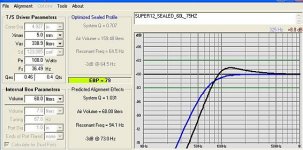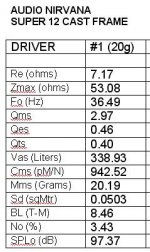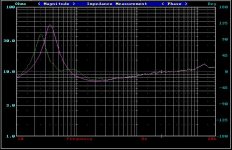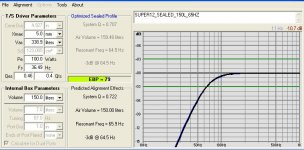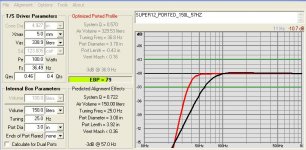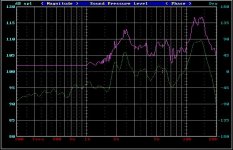The Super 12 just came in for testing. Results of T/S are below. Measured with LMS, Delta Mass (20g added weight). Loaded in a 60L Sealed Box. Bass response is adequate for most music.
Regards
Mike
Regards
Mike
Attachments
super twelve
Super 12 clones have been created for the Audio Nirvana. I hope some enterprising designer will use these params for a new treatment -- something to get the build excitement going.
For caveman audio, a tweak with a tweeter ala the original super 12 would be of interest.
I've thought about the Audio Nirvana Super 12 as a floor stander for a while now.
Original Hammer Super 12 tweaks page:
Single Driver Website
Super 12 clones have been created for the Audio Nirvana. I hope some enterprising designer will use these params for a new treatment -- something to get the build excitement going.
For caveman audio, a tweak with a tweeter ala the original super 12 would be of interest.
I've thought about the Audio Nirvana Super 12 as a floor stander for a while now.
Original Hammer Super 12 tweaks page:
Single Driver Website
Originally posted by loninappleton
I've thought about the Audio Nirvana Super 12 as a floor stander for a while now.
I think its best to put that on hold for a while. Initial listening indicates the Super 12 is not balanced. Too much upper mids and highs. Quite a bit of peaking too.
Will do some FR sweeps to see where the problems are.
Certainly no rush. I seldom get past the blue sky stage.
Even so a comparison with Hammer for better or worse would appreciated. In my early days reading at full range driver forum I always thought the Hammers were the nuts. The site creator Mr. Melhuish does too. He has built and features variations on the Hammer build but that is mostly in materials and does not veer from the recommended design.
Even so a comparison with Hammer for better or worse would appreciated. In my early days reading at full range driver forum I always thought the Hammers were the nuts. The site creator Mr. Melhuish does too. He has built and features variations on the Hammer build but that is mostly in materials and does not veer from the recommended design.
Iam newbee in testing, Why do you add 20 grams mass to the cone??The Super 12 just came in for testing. Results of T/S are below. Measured with LMS, Delta Mass (20g added weight). Loaded in a 60L Sealed Box. Bass response is adequate for most music.
Regards
Mike
Gustavo
P.S.: Maybe this 60 litres box is small, do you know the max cubic volume for this SUPER12CF ?
Last edited:
I am newbee in testing, why do you add 20 grams mass to the cone??
When you are testing a driver to determine the complete set of T/S parameters, you need to make two impedance curves.
The first impedance curve is the driver alone from which you can derive the Re, Lvc, fs, Qes, Qms, and Qts parameters.
You also need to estimate the driver cone's Sd using a ruler, typically it is the calculated projected area using the diameter taken at about 1/2 of the surround width.
Then you need to make a second impedance curve after either adding mass (typically small masses, I use US five cent coins because they are 5 gms each) or adding stiffness (mount in a small closed box of known volume) to shift the driver's fs by about 25%. Then based on the frequency shift, and the known added mass or stiffness, you can now calculate BL and Vas. This is done automatically by most testing software. Or it can be done with pencil and paper if you are measuring a driver the old fashioned way with an O-scope, signal generator, frequency counter, and volt meter.
Most books on speaker building will show you how to do these measurements. D'Appolito's book Testing Loudspeakers will tell you both how to make the measurements and theoretically why you are making these two measurements.
Thanks Mr.Martin for this full explanation. These tests are more complex than I thought.When you are testing a driver to determine the complete set of T/S parameters, you need to make two impedance curves.
Dear Mr.Michael Chua: Please keeps us informed about your SUPER12CF tests.
Thanks boys, Gustavo
Last edited:
These tests are more complex than I thought.
Automated testing software/hardware readily available to DIYers make these measurements easy, accurate, and quick. Woofer Tester, Praxis, ARTA, Sound Easy are just a few good examples. You don't need any special training, just follow the directions to get good results.
Automated testing software/hardware readily available to DIYers make these measurements easy, accurate, and quick. Woofer Tester, Praxis, ARTA, Sound Easy are just a few good examples. You don't need any special training, just follow the directions to get good results.
Nice, thanks for these test software. Do you think this Nirvana Super12CF is a good fullrange for a bass reflex no filter box??
Gustavo
Last edited:
Do you think this Nirvana Super12CF is a good fullrange for a bass reflex no filter box??
I believe most full range drivers in almost any form of resonant enclosure, like a BR or TL or BVR, would benefit from the addition of a BSC filter (passive or active EQ). In my opinion, the only way to completely avoid a filter is with a really well done BLH enclosure design. There are not many BLH designs available that will produce enough SPL output below the baffle step to eliminate the need for some kind of filtering to rebalance the SPL response. Filtering can be the obvious inductor and resistor combination, a tube amp with a shaped response, or very exotic speaker cable. They all change the SPL output as a function of frequency.
I think I afraid of the conseguences of this response. Thanks for clear.I believe most full range drivers in almost any form of resonant enclosure, like a BR or TL or BVR, would benefit from the addition of a BSC filter (passive or active EQ). In my opinion, the only way to completely avoid a filter is with a really well done BLH enclosure design. There are not many BLH designs available that will produce enough SPL output below the baffle step to eliminate the need for some kind of filtering to rebalance the SPL response. Filtering can be the obvious inductor and resistor combination, a tube amp with a shaped response, or very exotic speaker cable. They all change the SPL output as a function of frequency.
Excuse my ignorance, but what are a BVR and BLH boxes?
When you are testing a driver to determine the complete set of T/S parameters, you need to make two impedance curves.
Hi Martin
Thank you for taking the time for a detailed explanation.
Gustavo
You can see from the Free Air Impedance Sweep that Fs is 35Hz. The green plot is when 20g weight is added to the cone. Fs now is lower at 25Hz. With these readings, LMS calculates the T/S.
This is the first step because I don't depend on manufacturers' T/S. Some can be grossly different. Once with the actual T/S, it is easy to model the type of loading.
Based on a 150L box, a Sealed Box F3=65Hz. When loaded in Vented Box (Bass Reflex), F3= 57Hz. If you want lower, you can go down to F3=37Hz with a 329L Vented Box. That's a very big box for home use.
Personally, I wouldn't load the Super12 in a BR. According to their specs, Xmax = 1.0mm. Much safer in a Closed Box.
Attachments
I could prefer a sealed box, it is more easy to tuning than a BR. What do you think about a 419 litres sealed box for three Super12CF?Hi Martin
Thank you for taking the time for a detailed explanation.
Gustavo
You can see from the Free Air Impedance Sweep that Fs is 35Hz. The green plot is when 20g weight is added to the cone. Fs now is lower at 25Hz. With these readings, LMS calculates the T/S.
This is the first step because I don't depend on manufacturers' T/S. Some can be grossly different. Once with the actual T/S, it is easy to model the type of loading.
Based on a 150L box, a Sealed Box F3=65Hz. When loaded in Vented Box (Bass Reflex), F3= 57Hz. If you want lower, you can go down to F3=37Hz with a 329L Vented Box. That's a very big box for home use.
Personally, I wouldn't load the Super12 in a BR. According to their specs, Xmax = 1.0mm. Much safer in a Closed Box.
Excuse my ignorance, but what are a BVR and BLH boxes?
BLH = Back Loaded Horn. This is typically defined when the back of the driver's cone is firing into a small coupling chamber connected to a long expanding folded horn-like enclosure. The air in the long horn-like path exhibits standing waves at low frequencies similar to a TL.
BVR = Big Vent Reflex. This is typically defined when the back of the driver's cone is firing into a modest size coupling volume connected to a shorter expanding port that sort of looks like a short horn. A bass reflex typically has a larger volume box with a smaller cylindrical port. In a BVR the low frequency response is more bass reflex then horn, the coupling volume is a small stiff constant pressure spring and the expanding vent is an abnormally large moving mass, the two combine to produce the same low tuning frequency as a traditional bass reflex design. The physics of a bass reflex and a BVR are the same but the proportions are different.
How would this speaker go as an upper bass - mid range on an open baffle? Martin, you seem to have an instinct for open baffles. Any thoughts on using one of these with perhaps the Fostex tweeter mentioned on the full range site linked to earlier in this thread.
jamikl,
I think an OB design might be tough. I see two options, neither of which I have done any more work/thinking beyond typing this response. The problem is that the AN driver is 97+ dB/W/m efficient.
1. Run the AN full range and then try to blend a helper woofer to reinforce the bass lost due to the open baffle roll-off. The woofer or woofers would need to be efficient to prop up the loss of bass due to the baffle The down side is that the AN driver is forced to run full range and produce bass, but it is somewhat limited by the low Xmax value.
2. Cross the AN over to woofers around 200 Hz as I have done in the past on my OB designs. The down side here is that you will need woofer output that is 5 to 10 dB above the 97 dB/W/m of the AN driver. This would require multiple efficient woofers and/or an active crossover with plenty of boost capability.
I guess an OB design could be done if you are careful and select the right woofers and crossover plan. Being aware of the options and managing the design trade-offs is going to be the key.
Thanks Mr.Martin for this clear explanation, I can say I never see a such BVR enclosure, seems very interesting.BLH = Back Loaded Horn. This is typically defined when the back of the driver's cone is firing into a small coupling chamber connected to a long expanding folded horn-like enclosure. The air in the long horn-like path exhibits standing waves at low frequencies similar to a TL.
BVR = Big Vent Reflex. This is typically defined when the back of the driver's cone is firing into a modest size coupling volume connected to a shorter expanding port that sort of looks like a short horn. A bass reflex typically has a larger volume box with a smaller cylindrical port. In a BVR the low frequency response is more bass reflex then horn, the coupling volume is a small stiff constant pressure spring and the expanding vent is an abnormally large moving mass, the two combine to produce the same low tuning frequency as a traditional bass reflex design. The physics of a bass reflex and a BVR are the same but the proportions are different.
For now I have idea to put three Super12CF drivers in a around 420 litres traditional bass reflex box, if it have a good full range sound, what I have to see yet.
Gustavo
Below are the FR sweeps done at 0.5M_1W. Top plot is a 300 point precision Gated sweep from 1K-20K. Lower plot is without gating from 200Hz, smoothed 1/6 dB.
This confirms my initial listening test. The highs are definitely not well integrated. Quite shocking to see a response like that.
Looks like the tweeter starts at about 1K5 and ends at 7K5. Beyond that, its cone breakup.
Frankly, in its present state, its quite unbearable to listen to. Sounds like a raw extended range PA 12".
I'll see what can be done to minimize these irregularities passively.
This confirms my initial listening test. The highs are definitely not well integrated. Quite shocking to see a response like that.
Looks like the tweeter starts at about 1K5 and ends at 7K5. Beyond that, its cone breakup.
Frankly, in its present state, its quite unbearable to listen to. Sounds like a raw extended range PA 12".
I'll see what can be done to minimize these irregularities passively.
Attachments
- Status
- This old topic is closed. If you want to reopen this topic, contact a moderator using the "Report Post" button.
- Home
- Loudspeakers
- Full Range
- Audio Nirvana Super 12 Cast Frame measured T/S
